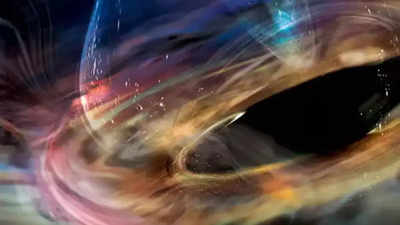- News
- Science News
- Black holes cook their own meals, according to NASA’s Chandra X-ray study; here’s how
Black holes cook their own meals, according to NASA’s Chandra X-ray study; here’s how
Scientists have found that supermassive black holes self-grow by regulating the cooling of surrounding hot gas, forming warm gas filaments that they consume. This discovery enhances the understanding of black holes' interactions with their environments and their role in galaxy evolution, facilitated by advanced imaging techniques from NASA and the VLT.
Scientists discovered something new and have opened the lid on black holes' behaviour. Researchers used NASA's Chandra X-ray Observatory and the Very Large Telescope data to find conclusive evidence that huge black holes can feed themselves. Such a discovery opens very important aspects regarding the complex relationship between black holes and the gas around them.
Supermassive black holes generate emissions to regulate the cooling of the hot gas
The research was conducted in several galaxy clusters, two of the most well-known being Perseus and the Centaurus clusters.
Budget 2025 Updates
Astronomers combined data from NASA's Chandra X-ray Observatory and the VLT to create a comprehensive view of how these massive black holes interact with their surroundings. Images taken with the high resolution of hot gas, represented by blue, have been provided through the Chandra X-ray Observatory while the VLT provided optical data as shown in red. This whole process was thereby made clearer as the scientists monitored images of how the released energy from the black holes regulates the behavior of the surrounding gases.
Black hole jets initiate cooling cycles driving galaxy cluster evolution
A great fraction of the dynamic processes in a galaxy cluster occurs due to cooling initiated by black hole jets. The hot gas cools as it forms filaments that flow toward the black holes. So, this continuous cycle of cooling and feeding results in the evolution of the growth of the black holes. Interactions between the hot and warm gas are so important that, for the first time, astronomers can directly relate the two types of brightness within the centers of galaxy clusters. Bright regions of hot gas matched consistently bright warm filaments throughout. This supports the theory that black holes are actively driving this gas cycle.
Recent study uncovers cosmic connection between black hole filaments and jellyfish galaxy tails
The surprise in the study was that filaments around black holes looked like the jellyfish galaxy tails. Jellyfish galaxies are those from which gas evaporates as they move through their galactic environments. A tail-like structure is produced as a result. This is an interesting similarity, which may point out a common cosmic mechanism responsible for both of these phenomena. It is a connection that hints at a deeper, universal process that may be responsible for shaping gas dynamics across different galaxy types.
The research is a collaborative study led by Valeria Olivares from the University of Santiago in Chile, and it involved researchers from different institutes in the world. One of the key instruments that was used for this research was MUSE (Multi Unit Spectroscopic Explorer) on the VLT, where scientists were able to image cosmic structures in 3D. This advanced technology enabled astronomers to gain detailed, three-dimensional views of the galaxy clusters, providing crucial data about the interaction between black holes and their environment.
Black holes' self-sustaining growth and impact on galaxy evolution revealed
This is a momentous discovery in astrophysics, since it has revealed that black holes can feed themselves by driving gas cooling and filament formation. A new understanding of how black holes interact with their environment offers great insight into the role of these cosmic giants in the evolution of galaxies. With the joint workings of the Chandra X-ray Observatory of NASA and VLT, along with advanced techniques used for imaging, wide prospects have been unveiled towards the understanding of behavior in black holes and their impact on the entire universe.
Through this study, astronomers are now better equipped to explore the complexities of black holes and their influence on the galaxies they inhabit. This research not only enhances our knowledge of these mysterious objects but also deepens our understanding of the fundamental processes that govern the evolution of the cosmos.
Also Read | Fast radio burst discovered in an ancient 11.3 billion-year-old galaxy
End of Article
FOLLOW US ON SOCIAL MEDIA












